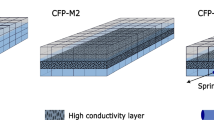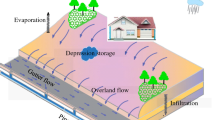Abstract
The planning and design of an outlet operation by releasing a turbid density current from a reservoir requires accurate prediction of outflow concentration for sluicing sediment through outlet structures. This study investigates outflow concentration and venting efficiency through reservoir outlets in a reservoir sluicing operation related to turbid density current. A 3D numerical model is employed to simulate a venting operation for a turbid density current in typhoon-induced flood events. A simple and efficient formula derived from theoretical analysis with experimental data is proposed for estimating outflow concentration and venting efficiency. By adopting the proposed formula to avoid time-consuming calculation using the 3D numerical model, the estimated outflow concentration and venting efficiency through reservoir outlets have shown good agreement with the measured and simulated results in typhoon flood events. This demonstrates that the formula provides an efficient approach for engineering practice in real-time reservoir venting operations.
Similar content being viewed by others
References
An, S. and Julien, P. Y. (2011). Interflow dynamics of turbid density currents in thermally stratified Imha Reservoir, S. Korea, Hydrology Days.
ANSYS, Inc. (2011). ANSYS CFX user’s guide 14.0.
Buehler, J. and Siegenthaler, C. (1986). “Self-preserving solutions for turbidity current.” Acta Mech., Vol. 63, pp. 217–233.
Celik, I. B., Ghia, U., Roache, P. J., Freitas, C. J., Coleman, H., and Raad, P. E. (2008). “Procedure for estimation and reporting of uncertainty due to discretization in CFD applications.” Journal of fluids Engineering-Transactions of the ASME, Vol. 130, No. 7, pp. 078001–1.
Chien, N. and Wan, Z. (1999). “Mechanics of sediment transport.” ASCE, Reston, Va., pp. 662–665.
Chikita, K. (1989). “A field study on density currents initiated from Spring Runoffs.” Water Resour. Res., Vol. 25, No. 2, pp. 257–271.
Chung, S. W., Hipsey, M. Y., and Imberge, J. (2009). “Modelling the propagation of turbid density inflows into a stratified lake: Daecheong Reservoir, Korea.” Environmental Modelling & Software, pp. 1467–1482.
De Cesare, G. and Boillat, J. L. (2003). “Intrusive and bottom density currents and induced vertical exchanges in a stratified lake.” Proc., 30th IAHR Congress, Theme C, Thessaloniki, Greece, pp. 381–388.
De Cesare, G., Boillat, J. L., and Schleiss, A. (2006). “Circulation in Stratified Lakes due to Flood-Induced.” J. Environ. Engrg., Vol. 132, No. 11, pp. 1508–1517.
De Cesare, G., Schleiss, A., and Hermann, F. (2001). “Impact of density currents on reservoir sedimentation.” J. Hydraul. Eng., Vol. 127, No. 1, pp. 6–16.
Ellison, T. H. and Turner, J. S. (1959). “Turbulent entrainment in stratified flows.” J. Fluid Mech., Vol. 6, No. 3, pp. 423–448.
Fan, J. H. (2008). “Stratified flow through outlets.” Journal of Hydroenvironment Research, Vol. 2, Issue 1, pp. 3–18.
Fan, J. and Morris, G. L. (1992a). “Reservoir sedimentation I: Delta and density current deposits.” ASCE, J. Hydraul. Eng., Vol. 118, No. 3, pp. 354–369.
Fan, J. and Morris, G. L. (1992b). “Reservoir sedimentation II: Reservoir desiltation and long-term storage capacity.” ASCE, J. Hydraul. Eng., Vol. 118, No. 3, pp. 370–384.
Hocking, G. C. and Forbes, L. K. (2001). “Super-critical withdrawal from a two-layer fluid through a line sink if the lower layer is of finite depth.” J. Fluid Mech., Vol. 428, No. 1, pp. 333–348.
Lai, J. S. (2006). A Study of density current and operation of reservoir desiltation, Hydrotech Research Institute, NTU, Report No. 692 (in Chinese).
Lee, H. Y. and Yu, W. S. (1997). “Experiment study of reservoir density current.” J. Hydraul. Eng., Vol. 123, No. 6, pp. 520–528.
Morris, G. L. and Fan, J. (2009). Reservoir sedimentation handbook, Electronic Version, Ver. 1.01.
Oehy, C. D. and Schleiss, A. J. (2007). “Control of Turbidity Currents in Reservoirs by Solid and Permeable Obstacles.” Journal of Hydraulic Engineering, Vol. 133, No. 6, pp. 637–648.
Parker, G., Fukushima, Y., and Pantin, H. M. (1986). “Self-accelerating turbidity currents.” J. Fluid Mech., Vol. 171, pp. 145–181.
Richardson, J. F. and Zaki, W. N. (1954). “Sedimentation and fluidzation, Part I.” Trans. Inst. Chem. Engrs., Vol. 32, pp. 35–53.
Shen, H. W. and Lai, J. S (1996) “Sustain reservoir useful life by flushing sediment.” Intl. Jour. of Sediment Research, IRTCES, Vol. 11, No. 3, pp. 10–17.
Sung, C. C. and Lai, J. S. (2009). Establishment of sediment concentration observation system with monitoring, determination and analysis in Tsengwen reservoir, Hydrotech Research Institute, NTU, Report No. 805 (in Chinese).
Weirich, F. H. (1984). “Density currents: Monitoring their occurrence and movement with a three-dimensional sensor network.” Sci., Vol. 224, No. 4647, pp. 384–387.
Yellow River Conservancy Commission (2006). Proceedings of symposium on density flow investigation, Yellow River Water Conservancy Publishing House.
Young, D. L. and Lin, Q. H. (1991). “Density currents during a storm in Te-Chi reservoir of Taiwan.” Proc., 24th IAHR Congr., International Association for Hydraulic Research, Delft, The Netherlands, pp. 801–810.
Yu, W. S., Hsu, S. H., and Fan, K. L. (2004). “Experiments on selective withdrawal of a codirectional two-layer flow through a line sink.” J. Hydraul. Eng., Vol. 130, No. 12, pp.1156–1167.
Author information
Authors and Affiliations
Corresponding author
Rights and permissions
About this article
Cite this article
Lee, FZ., Lai, JS., Tan, YC. et al. Turbid density current venting through reservoir outlets. KSCE J Civ Eng 18, 694–705 (2014). https://doi.org/10.1007/s12205-014-0275-y
Received:
Revised:
Accepted:
Published:
Issue Date:
DOI: https://doi.org/10.1007/s12205-014-0275-y




